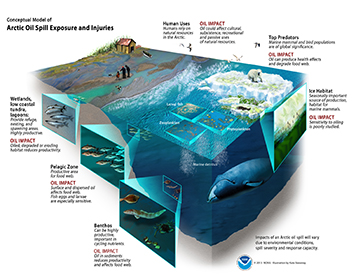Activities in the Arctic
Conditions in the Arctic are changing rapidly. NOAA estimates that within the next 30 years the Arctic Ocean will be free of multi-year ice in the summer, increasing opportunities for maritime transportation, tourism, and oil and gas exploration. However, "ice-free" seasonal conditions still present hazards to navigation: unpredictable ice conditions, moving ice floes, unsettled weather, and wave patterns. Vessels transiting the Arctic have little or no emergency response infrastructure for support. This means that when oil does spill, the consequences can be much more severe, and search and rescue missions can face even greater difficulties.
NOAA's Office of Response and Restoration (OR&R) is building on decades of experience in Alaska to ensure the safety of Alaskan communities, ecosystems, and local economies while supporting a rising demand for maritime access and offshore development in the Arctic.
Our Work in the Arctic
- Arctic ERMA: We are developing an Arctic Environmental Response Management Application, a critical GIS tool to support decision makers during oil spills and training exercises.
- Spill Response and Training Support: OR&R is the lead science adviser to the U.S. Coast Guard during oil spill response operations in Alaska and maintains a role on the Alaska Regional Response Team.
- Preparing for Natural Resource Damage Assessment: Natural resources in the Arctic, including many with cultural and subsistence value for Arctic communities, are at risk from oil spills (see image at right). OR&R is collecting information on Arctic ecosystems and planning to ensure that a Natural Resource Damage Assessment and any resulting restoration is effective in the event of an oil spill.
- Marine Debris Removal, Research, and Education: Since 2006, the NOAA Marine Debris Program has worked with partners to conduct debris research, removal, and prevention, directly funding more than 35 projects in Alaska that have removed over 900 metric tons of debris from shorelines.
- Collaborative Research and Planning: OR&R has initiated the Arctic Joint Assessment Team and assisted the Arctic Council, Canada, and Norway in developing Arctic spill response techniques and planning for spills in Arctic waters. We have also advised University of Alaska research and participated in joint industry and intergovernmental contingency planning.
Learn about resources related to OR&R's involvement in Arctic issues.
 An official website of the United States government.
An official website of the United States government. 

